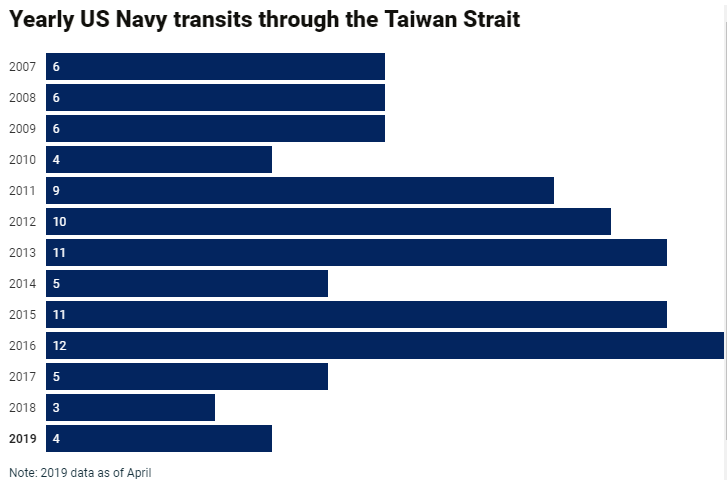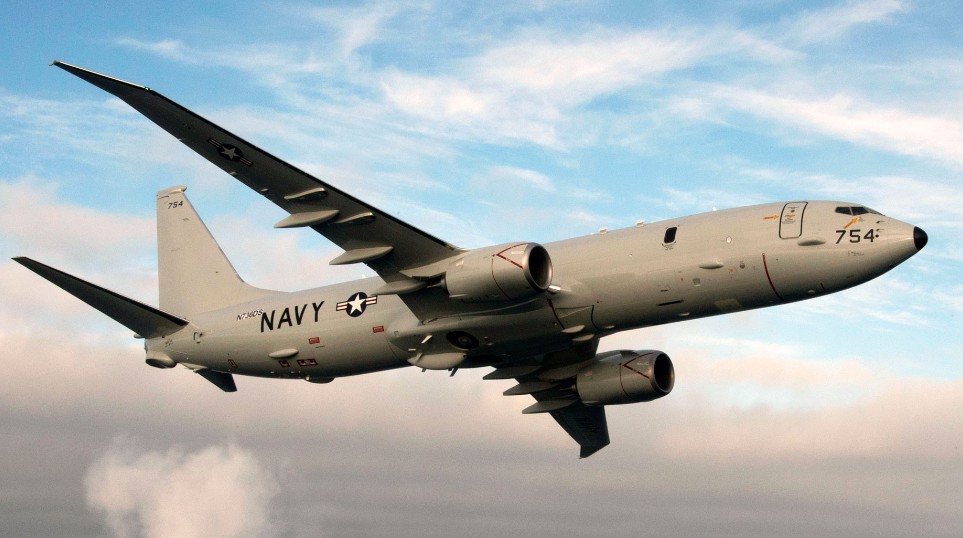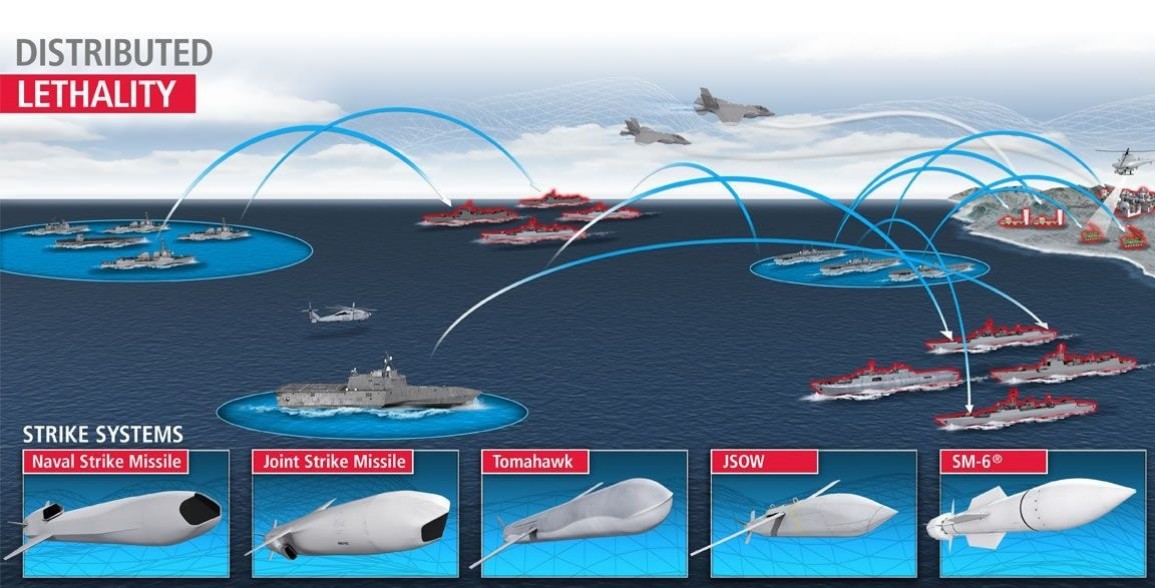Since the end of World War II, the United States has executed a variety of complex military operations in the South China Sea, which can generally be classified into six categories: declaratory actions, presence operations, military reconnaissance and intelligence collection, drills and training, battlefield construction and validation of operational concepts, and deterrent action. In which, the well-known freedom of navigation operations (FONOPs) are among those declaratory actions. Besides, there were also various highly intensive operations in wartime. These six kinds of military operations themselves in the South China Sea are not news and not surprising, but, the abnormal increase in their frequency, intensity, and pertinence to China in recent years, deserves intensive attention.
Ⅰ. Declaratory actions.
Declaratory actions are conducted to project rules with power, namely, to declare oneself by challenging maritime assertions that one regards as unreasonable through the exercise of military power. Currently, the declaratory actions carried out by the US in the South China Sea and its surrounding areas include mainly FONOPs and Transit through the Taiwan Strait. FONOPs, initiated by the Carter Administration in 1979, are untenable based on International Law. At that time, with the negotiation on the United Nations Convention on the Law of the Sea (hereinafter referred to as the Convention) nearing its end, the US was worried that the Convention, if taken effect and put into practice, would encourage excessive maritime claims of other coastal states, impeding the freedom of the US, especially its military operations worldwide. Therefore, the US launched FONOPs beyond the framework of the Convention to challenge the so-called excessive maritime claims, through military and diplomatic means. In the eye of the US, the excessive maritime claims include the historic claims, inconsistent territorial sea baselines with the UNCLOS, limits on innocent passage within 12 nautical miles, territorial sea claims beyond 12 nautical miles, limits on military operations within exclusive economic zones (EEZ), and unreasonable archipelagic baselines or passage limitations. FONOPs targeted at China in the South China Sea mainly include an application for innocent passage within territorial waters in advance, military jurisdiction within EEZ, and excessive straight baselines, etc.
Another important declaratory operation conducted by the US against China around the South China Sea is Transit through the Taiwan Strait. The US hopes to declare its intentions on Cross-strait policies through such actions, namely that it is not allowed to change the status quo unilaterally. From 2007 to April 2019, there is no huge difference in frequency in US military passage across the Taiwan Strait but a comparatively higher exposure rate in recent two years, showing the increasingly high-profile and politicization tendencies of the US military operations against China.


Yearly US Navy transits through the Taiwan Strait, source: SCMP
Ⅱ. Presence operations.
Given the US strategy of maritime hegemony, the South China Sea remains a significant sea area where the US maintains its powerful presence including routine patrols, sailing of ships and aircrafts, and port visits. One is regular surface, underwater and air patrols. So far, according to official statistics from the US Indo-Pacific Headquarters, on average, there are three American military vessels in the South China Sea every day and about 900 ship days in total all year round, compared with only 700 in the years before and after 2015. In 2004, the US Asia-Pacific Air Force initiated Continuous Bomber Presence (CBP) operations, which transformed into remarkable actions highlighting US military presence. In 2018, the US boasted over 30 sorties of B-52 bombers patrolling the South China Sea, which has been rarely seen since the end of the Cold War. Second, there is the crossing of military ships and aircrafts. Connecting two oceans and three continents, the South China Sea serves as an important maritime channel frequented by American vessels and airplanes for intra- or inter-command force maneuvers and strength deployment. Third, there are mass of port visits. The US has been sending warships to visit the ports of China and other coastal states of the South China Sea to expand its military and diplomatic influence on the region. For instance, from March 5th, 2019 to March 9th, 2019, the USS Carl Vinson Strike Group visited Vietnam, which was the first time the US visited Vietnam since the Vietnam War ended in 1975, marking warming US-Vietnam military relationships.
Ⅲ. Military reconnaissance and intelligence collection.
As a key area under the watch of the US military force for air reconnaissance and intelligence collection, the South China Sea has witnessed the most frequent actions of this kind, with nearly 2-4 sorties of various reconnaissance airplanes conducting missions in the waters, totaling thousands of sorties a year. The tragedy of the 2001 accident, namely, the collision of the US EP-3 and China-F8, resulted from the American EP-3 reconnaissance activities. Both the US Navy and Air Force have sent reconnaissance aircrafts to the South China Sea, such as P-8A and P-3C from the Navy, RC-135 and Global Hawk Drone from the Air Force, and other ship-based reconnaissance airplanes taking off from aircraft carriers and other military vessels in the waters like E-2D or SH-60 Seahawk Helicopters. Additionally, there are more than 10 vessels belong to U.S. Military Sealift Command for reconnaissance and measurement, including missile range instrumentation ships, oceanographic survey ships and ocean surveillance ships, operating in the South China Sea. The missile range instrumentation ships are deployed near shores of China to detect data when China launching missiles, while oceanographic survey ships and ocean surveillance ships focus on oceanographic research and hydrological survey to obtain accurate and detailed battlefield information like submarine topography, shallow seabed sections, and seabed surface geology, as well as temperature, density, and salinity of sea water. There have been several incidents involving U.S. ocean surveillance ships of USNS Impeccable (T-AGOS-23) and survey ships of USNS Bowditch (T-AGS-62) happened in the South China Sea. Oceanographic research vessels affiliated with American universities also undertake some military research programs, like the R/V Thomas G. Thompson (T-AGOR-23), once docked in Taiwan Strait in 2018, which operated by the University of Washington, yet belongs to the US navy. Roughly estimated, the frequency of the US reconnaissance and intelligence collection activities in 2018 has increased by at least 100% and even more compared with that in 2010.


P-8A Poseidon maritime surveillance aircraft, source: www.ainonline.com
Ⅳ. Military exercises and trainings.
The South China Sea is an important venue for the US Military to conduct training and exercises, including unilateral, bilateral, and multilateral drills. Every year the Seventh Fleet alone conducts hundreds of drills in the South China Sea and its surrounding areas. In addition, there are drills of the Third Fleet, the Air Force, Marines and Army of the US, totaling around 150 exercises which have names about every year. The number and pertinence of those drills have been increased and strengthened significantly over the past two years. Patrick Shanahan, the then Acting US Secretary of Defense, confirmed in March 2019 that “the US Department of Defense has increased its participation in regional joint military exercises by 17 percent over the past two years.” Since the South China Sea is of vital importance to American military forces in the Indo-Pacific region, they might have conducted higher growth rate of joint military exercises in the South China Sea and surrounding areas than elsewhere. The drills are usually worth mentioning and the training times are countless. It is safe to say that there are US military training in the South China Sea at any time on any day. The United States has seized every chance to conduct joint military exercises and trainings in the South China Sea with its allies and partners. As long as they meet in the area, they would engage in some joint drills. According to the official website of the Seventh Fleet, warships from the US Navy, Indian Navy, Japanese maritime self-defense force and Philippine Navy sailed in groups in the South China Sea from May 2nd 2019 to May 8th 2019, and conducted various joint military trainings during this period.
Ⅴ. Battlefield construction and validation of operational concepts.
The US military has taken seriously possible competition and even armed conflicts with China in the South China Sea after 2015, and proposed a series of operational concepts against China, such as the concept of “Distributed Lethality” by US Navy, the “Multi-Domain Battle” by US Army, and the “Expeditionary Advanced Base Operations” (EABO) by US Marines. These concepts mostly assume the South China Sea as the battlefield, and construct strategies and war-game simulation under that premise. Once launched, the concepts also need to be field validated in the South China Sea. The US military has clearly been gearing up for conflicts with China on the South China Sea in recent years. As the number of attack submarines, strategic bombers, and surface warships of the United States engaged in intensified joint military exercises centering on the South China Sea increases, together with war rhetoric against China from high-ranking US military officials, the situation in the South China Sea is becoming tenser than ever.


Distributed Lethality, Source: www.raytheon.com
Ⅵ. Deterrent action.
Deterrent action refers here to the action taken during a sensitive period or regularly by sending strategic platforms to the South China Sea to deter any potential military actions from other countries. The first category is the Carrier Strike Group (CSG). The United States sent around four CSGs to the South China Sea in 2018, each of which stayed for different time periods ranging from one to three months. The second category includes the Amphibious Readiness Group (ARG), which mainly consists of amphibious assault ships. The United States also sent four ARGs to the area last year. The third category is composed of nuclear submarines, which includes nuclear attack submarines and nuclear-powered ballistic missile submarines. Based on current public AIS data, there is an increasing frequency for nuclear attack submarines to show up in the South China Sea. The movement of nuclear-powered ballistic missile submarines belongs to the “top secret,” inaccessible classification of the United States, but there is no doubt that the South China Sea serves as an important area under their deployment. The fourth category includes the strategic bomber, which shows a very strong intention of demonstration and deterrence while conducting CBPs in this area.
It should be noted that the six above-mentioned military actions usually do not exist independently but are related to each other. The US Military often performs multiple tasks simultaneously to achieve multiple goals. For example, the cruise of strategic bombers and CSGs in the South China Sea can be regarded as a presence operation with deterrence functions. During the cruise, they also surely conduct various drills and training. Take another case, there is hardly any chance that the US military would send a special warship to simply conduct FONOPs within 12 nautical miles of the South China Sea islands and reefs. In the meantime, the warship definitely has other multiple tasks.
In conclusion, the US military has been conducting complex military actions in the South China Sea, featuring large scales and high frequency. It is estimated that the US has averagely three warships and two to four different aircrafts operating in the South China Sea every day, let alone the activities of space-based satellites. Despite persisting existence since the end of the Second World War, these actions have seen an abnormal increase in their frequency, intensity, and pertinence in recent years, which indicates a remarkable change that deserves intensive attention. The US military’s various actions suggest different military values and significance. The reason why FONOPs has gained so much attention is that they have been highly exposed to the public since 2015. However, it is insignificant compared with the aggregate volume of actions conducted by the US Military in the South China Sea. The importance of FONOPs should not be underestimated, but it would be putting the cart before the horse if people focus too much on FONOPs to neglect other actions by the US military and their representing policy tendencies.

